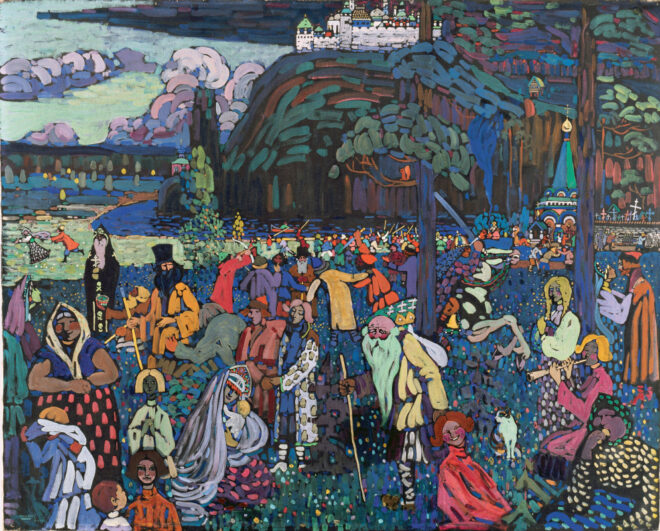In the case of the heirs of Hedwig Lewenstein Weyermann and Irma Lewenstein Klein v. Bayerische Landesbank, the Advisory Commission’s decision recommending the restitution of Wassily Kandinsky’s painting Das bunte Leben (The Colourful Life) was published on 13 June 2023. Following a decision to that effect by the Bavarian Landtag, the federal state’s legislature, Bayerische Landesbank has now decided to accept the recommendation and to return the painting. Bayerische Landesbank is a public sector bank owned by the Bavarian state and the Bavarian Sparkassen.
Provenance
Wassiliy Kandinsky painted “Das bunte Leben” in early 1907 in Sèvres near Paris; it is considered a key work of his early artistic phase. In 1919/20, it was acquired by Paul Citroen, who worked for the Sturm Gallery in the Netherlands, from that gallery.
In November 1927, Citroen sold the painting to Emanuel A. Lewenstein and his wife Hedwig Lewenstein Weyermann, relatives of the Citroen family. After Emanuel’s death in 1930, Hedwig became the sole owner of the painting. In 1933, she loaned it to the Stedelijk Museum in Amsterdam. In 1937, Hedwig’s will specified that her estate would be divided equally between her two children, Robert and Wilhelmine Lewenstein, with the collection of paintings and etchings to be divided into two equal parts and distributed to the heirs by lot. It is unclear whether that procedure was followed.
In September 1940, the painting was collected from the Stedelijk Museum by a courier of the Jewish art dealer Abraham Mozes Querido. It was later auctioned on 9 October 1940, by Frederik Muller & Co. The exact circumstances surrounding the consignment and sale of “Das bunte Leben” remain unlear.
Bayerische Landesbank argued that it was a voluntary sale in the course of divorce proceedings between Robert Lewenstein and his then wife Irma. On the other hand, Querido had business links to art dealer Alois Miedl who was instrumental in the Nazi art looting in the Netherlands. In the same 8/9 October 1940 auction, parts of the famous Goudstikker collection were sold. As regards the Goudstikker collection, it is a well established case of a forced sale to Alois Miedl.
What is known, however, is that the art work was acquired at the auction by the Jewish collector Salomon B. Slijper. During the German occupation of the Netherlands, he hid the painting in the Stedelijk Museum’s depot. After Slijper’s death in 1971, his widow offered the painting for sale, leading to its acquisition by the Bayerische Landesbank. It has been on permanent loan to Munich’s Städtische Galerie im Lenbachhaus.
Recommendation
It was undisputed that the ancestors of the claimants were victims of Nazi persecution. Most of the other points, it appears, were in dispute however: Bayerische Landesbank even argued that the German “Guidelines for implementing the Statement by the Federal Government, the Länder and the national associations of local authorities on the tracing and return of Nazi-confiscated art, especially Jewish property” were not applicable,. Rather, the matter should be dealt with in accordance with the Dutch regulations, since all relevant events took place in the Netherlands.
However, the Guidelines clearly state that they also apply to transactions that took place “in countries occupied by German forces after the outbreak of World War II, on 1 September 1939.” Therefore, the Guidelines applied to the October 1940 auction as it took place after 10 May 1940, the day German troops invaded the Netherlands.
Under the Guidelines, a transactional loss that occurred during the period of persecution is generally presumed to be seizure as a result of persecution, if the owner was persecuted.The burden of proof to refute this presumption was on Bayerische Landesbank.
In its recommendation, the Advisory Commission decided on the basis of that allocation of the burden of proof. It found that, even though the details of the 1940 remain unclear, “there are numerous indications that this was a case of a seizure as a result of Nazi persecution as defined in the Guidelines. The arguments put forward by the Bayerische Landesbank are not capable of disproving this.”
In reaching this conclusion, the Advisory Commission attached particular weight to the fact that the Lewenstein painting was sold in the same auction that constituted the first major sale of the “aryanised” Goudstikker collection, and to the links between Querido and Miedl.
Dutch Restitution Case: “Bild mit Häusern”
In a related case, the Dutch Advisory Committee on the Assessment of Restitution Applications for Items of Cultural Value and the Second World War (Adviescommissie Restitutieverzoeken Cultuurgoederen en Tweede Wereldoorlog) – in short the Restitutions Committee – dealt with a Lewenstein family resutution request concerning Kandinsky’s “Bild mit Häusern” (Painting with Houses) in the possession of Amsterdam’s Stedelijk Museum. In 2018, the Restitutions Committee held that that the interest of the applicant in restitution did not outweigh the interest of the City of Amsterdam in retaining the work.
This recommendation notwithstanding, in 2021, the City of Ansterdam decided to enter into consultation with the heirs in order to arrive at a settlement agreement , and such a settlement was reached in February 2022. The painting was handed over to the heirs.

